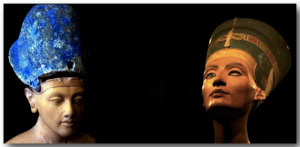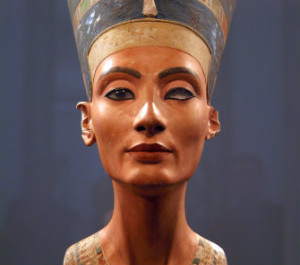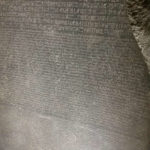Who Was Queen Nefertiti?
Queen Nefertiti is considered one of the most beautiful and powerful women of Ancient Egypt. Mystique surrounding her life and disappearance from Egyptian historical records still exists, reignited by the potential recent discovery of her tomb.
Queen Nefertiti’s Early Life and Reign
The mystery surrounding Nefertiti’s life extends all the way back to her birth around 1390 B.C. and continues throughout her rein alongside Amenhotep IV. Speculation still exists over the identity of her parents. Some sources suggest that Nefertiti was actually a princess from a kingdom in Syria and not Egyptian. Tour Egypt explains, “Nefertiti may or may not have been of royal blood.” The possibility that “Nefertiti may have been a daughter of Tiye, or that she was Akhenaten’s cousin” still exists. Most sources believe that Ay, a top military advisor who became pharaoh after the death of King Tut, fathered Nefertiti.
Queen Nefertiti married sixteen-year-old Amenhotep IV at the age of fifteen. Amenhotep IV began making drastic changes in his fifth year as pharaoh, supported by Nefertiti. He displaced Egyptian chief supreme god Amon (or Amen-Ra) with the sun god Aten. Amenhotep IV claimed that he and Queen Nefertiti were the only humans able to converse with Aten; therefore, the common people worshipped the royal family.
Nefertiti supported her husband when he changed his name to Akhenaten, which means “He who is of service to the Aten” or “Effective spirit of Aten”. Akhenaten commissioned the building of a new capital city at Armana, along the banks of the Nile River to worship Aten.
Personal Life of Queen Nefertiti and Akhenaten
After Amenhotep IV changed his name, Nefertiti took on the additional name “Neferneferuaten.” Different translations of this name exist, with some translated it, “Beautiful are the beauties of Aten, a Beautiful Woman has come,” while other sources say it means “The Aten is radiant of radiance because the beautiful one is come.”
Although Akhenaten had other wives, there is little doubt of the deep love between Nefertiti and Akhenaten. Queen Nefertiti bore six daughters but no male heir. Another wife, Kiya, Akhenaten’s own sister, gave birth to Akhenaten’s two sons, one of whom was Tutankhamen (King Tut).
Nefertiti reigned as a Queen with great power not usually granted to other queens, not even the Chief Royal wife. History Channel points to the fact that Nefertiti is often “shown in positions of power and authority—leading worship of Aten, driving a chariot or smiting an enemy.”
What Happened to Queen Nefertiti?
Nefertiti disappeared from Egypt’s historical records around the twelfth year of the 17 years of Akhenaten’s reign. Some scholars suggest she fell out of favor with Akhenaten, with all images of her being subsequently removed from monuments. Akhenaten actually removed images of Kiya, not Queen Nefertiti.
Others believe Nefertiti simply died around the age of 30 and that Akhenaten, overcome with grief, did not want to be reminded of her publicly. Another explanation suggests that the co-regent to Akhenaten, appointed shortly after Nefertiti’s disappearance from historical records, was actually Nefertiti, who had taken on the guise of a female king, not unheard of at the time.
Has Nefertiti’s Tomb Been Discovered?
The discovery of an ancient painted limestone bust of Queen Nefertiti in 1913 reignited interest in Nefertiti. University of Arizona archaeologist and Egyptologist Nicholas Reeves recently announced that he believes he discovered the final resting place of Queen Nefertiti. Reeves believes that fissures and cracks along a wall in King Tut’s tomb lead to a secret passageway and ultimately to Nefertiti’s tomb.
Reeves suggests that the undisturbed resting place of the legendary Queen Nefertiti could be on the other side of the walls of the boy-king’s burial chamber. Reeves told the BBC “If I’m wrong, I’m wrong.” He went on to say that if he is right, “The world will have become a much more interesting place—at least for Egyptologists.”







